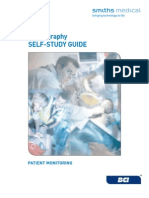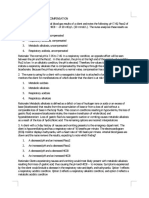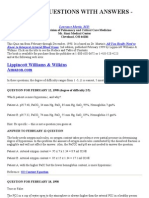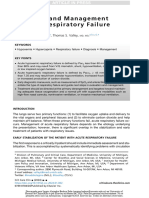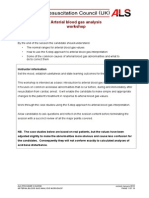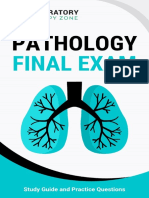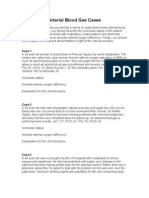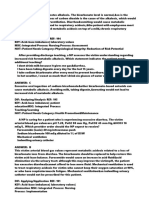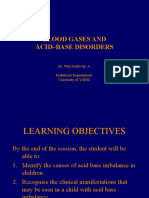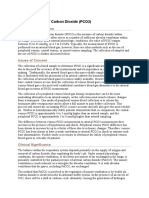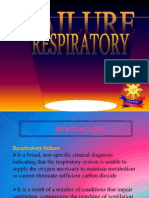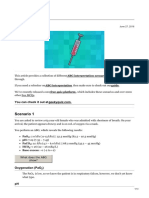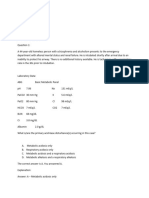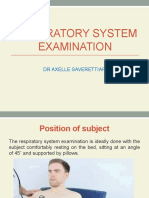Chapter 20
Chapter 20
Uploaded by
Bettina DavenportCopyright:
Available Formats
Chapter 20
Chapter 20
Uploaded by
Bettina DavenportCopyright
Available Formats
Share this document
Did you find this document useful?
Is this content inappropriate?
Copyright:
Available Formats
Chapter 20
Chapter 20
Uploaded by
Bettina DavenportCopyright:
Available Formats
TESTBANK Chapter Title: Pulmonary Diagnostic Procedures Chapter #: 20
Questions 1-3 refer to the following situation. 1. On admission a patient presents as follows: pH 7.38; RR 24, regular, pursed lip breathing; PaO2 66; HR 112, sinus tachycardia; PaCO2 52; BP 110/68; HCO3- 30; SpO2 90% on O2 2 liters/min nasal cannula. These gases show: 1. compensated metabolic alkalosis. 2. compensated respiratory acidosis. 3. compensated metabolic acidosis. 4. compensated respiratory alkalosis.
Topic: Pulmonary Cognitive Level: Application Correct answer: 3 Rationale: The pH is closer to the acidic level, therefore the
primary disorder is acidosis. The increased PaCO2 is the cause of the acidosis, and the pH is normal (7.35-7.45) so this is compensated respiratory acidosis with metabolic alkalosis. Page Reference: 537-539
2. Which of the following diagnoses would be most consistent
with the above ABG values? 1. Acute pulmonary embolism 2. Acute myocardial infarction 3. Congestive heart failure 4. Chronic obstructive pulmonary disease
Topic: Pulmonary Cognitive Level: Application Correct answer: 4 Rationale: The fact that the HCO3- level has increased
enough to compensate for the increased pCO2 level indicates that this is not an acute condition because the kidneys can take several days to adjust. The other choices would present with a lower HCO3- level. Page Reference: 538
3. What treatment could you expect the physician to order for
this patient? 1. Increase O2 to 6 L/min. 2. Prepare for emergency intubation. 3. Administer 1 amp of sodium bicarbonate. 4. Repeat ABG in 4 hours.
Topic: Pulmonary Cognitive Level: Analysis Correct answer: 4 Rationale: Increasing the FiO2 on this patient could decrease
the respiratory rate and increase the severity of the patients CO2 retention. The patients ABG values do not warrant intubation at this time. Additional sodium bicarbonate is not indicated because this patient has a fully compensated pH. A repeat ABG may be ordered to assess the patients ongoing respiratory status. Page Reference: 540
4. A patients assessment data are as follows:
pH 7.10 RR 34 PaCO2 60 HR 128 PaO2 40 BP 180/92 HCO320 This is best described as: 1. uncompensated respiratory acidosis. 2. uncompensated metabolic acidosis. 3. compensated metabolic acidosis. 4. compensated respiratory acidosis. 5. Which of the following formulas represents the correct calculation of the anion gap? 1. Na+ (Cl- - HCO3-) 2. Na+ Cl- HCO33. (Cl- + HCO3-) Na+ 4. Na+ - (Cl- + HCO3-)
Topic: Pulmonary Cognitive Level: Application Correct answer: 1 Rationale: The pH is below normal range (7.35-7.45) so this
is an uncompensated acidosis. The PaCO2 is markedly elevated, and the HCO3- is normal. This indicates an uncompensated respiratory acidosis. Page Reference: 537-539
Topic: Pulmonary Cognitive Level: Knowledge Correct answer: 4 Rationale: The correct formula for calculating the anion gap
is extracellular fluid cations (Na+) minus extracellular fluid anions (Cl-) plus measured bicarbonate level (HCO-3). Page Reference: 541
Copyright 2003, Elsevier Science (USA). All rights reserved.
6. A patient presents with the following values: pH 7.20; pO2
106; pCO2 35; HCO3- 11. These values are most consistent with: 1. uncompensated respiratory acidosis. 2. uncompensated metabolic acidosis. 3. uncompensated metabolic alkalosis. 4. uncompensated respiratory alkalosis. 7. Which of the following symptoms would be most consistent with the previous values? 1. Diarrhea 2. Shortness of breath 3. Central cyanosis 4. Peripheral cyanosis
Topic: Pulmonary Cognitive Level: Application Correct answer: 2 Rationale: The pH indicates acidosis, and the HCO3- is
markedly decreased indicating a metabolic disorder. Page Reference: 537-539
Topic: Pulmonary Cognitive Level: Comprehension Correct answer: 1 Rationale: Diarrhea is one mechanism by which the body
can lose large amounts of HCO3-. The other choices are indications of hypoxia, which is not indicated with a pO2 of 106. Page Reference: 538
8. For which of the following conditions is bronchoscopy
indicated? 1. Pulmonary edema 2. Ineffective clearance of secretions 3. Upper GI bleed 4. Installation of surfactant
Topic: Pulmonary Cognitive Level: Comprehension Correct answer: 2 Rationale: Bronchoscopy visualizes the bronchial tree. If
secretions are present, they can be removed by suctioning and sent for culture to help adjust antibiotic therapy. Page Reference: 543
9. A patient presents moderately short of breath and dyspneic.
A chest x-ray examination reveals a large right pleural effusion with significant atelectasis. The physician is most likely to order which of the following procedures? 1. Thoracentesis 2. Bronchoscopy 3. V/Q scan 4. Repeat chest x-ray
Topic: Pulmonary Cognitive Level: Application Correct answer: 1 Rationale: A thoracentesis involves removal of excess
intrapleural fluid and is indicated for this patient. There is no evidence of a pulmonary emboli necessitating a V/Q scan. A bronchoscopy can not assist in fluid removal. There is no indication that there is a problem with this chest x-ray. Page Reference: 543
10. A 75-kg, 58 patient is on the ventilator. The physician
tells you that he believes the patient may be ready for extubation. He orders the following tests: NIF and VC. Which of the following results best suggest that the patient is ready for extubation? 1. NIP 10, VC 4600 2. NIP 18, VC 4700 3. NIP 22, VC 4400 4. NIP 24, VC 4800 11. Ventilation/perfusion (V/Q) scans are ordered to evaluate the possibility of which of the following? 1. Pulmonary emboli 2. Acute myocardial infarction 3. Emphysema 4. Acute respiratory distress syndrome
Topic: Pulmonary Cognitive Level: Application Correct answer: 4 Rationale: These values indicate that the patient is taking a
strong enough and deep enough inspiration to have the best chance of tolerating extubation. Page Reference: 544
Topic: Pulmonary Cognitive Level: Knowledge Correct answer: 1 Rationale: This test is ordered for the evaluation of
pulmonary emboli. ECG or cardiac enzymes are ordered to evaluate for MI; ABG, CXR, and pulmonary function tests are ordered to evaluate for emphysema. CXR and hemodynamic monitoring are ordered for evaluation of ARDS. Page Reference: 544
Copyright 2003, Elsevier Science (USA). All rights reserved.
12. A patient presents with absent lung sounds in the left
lower lung fields, moderate SOB, and dyspnea. You suspect pneumothorax, and notify the physician who orders a STAT chest x-ray examination. Which of the following findings best supports your suspicions? 1. Blackness in the left lower lung area 2. Whiteness in the left lower lung area 3. Blunted costophrenic angles 4. Elevated left hemidiaphragm 13. A COPD patient requires intubation. After the physician intubates the patient you auscultate for breath sounds. You are not sure of the breath sounds in this patient. Which of the following would best assist in determining endotracheal tube placement in this patient? 1. STAT chest x-ray examination 2. End-tidal CO2 monitor 3. V/Q scan 4. Pulmonary artery catheter insertion
Topic: Pulmonary Cognitive Level: Comprehension Correct answer: 1 Rationale: Whitened areas on a CXR can indicate fluid or
blood accumulation. Blackness indicates lack of lung tissue, which would be present with a pneumothorax. The other choices are not related to the pneumothorax. Page Reference: 546
Topic: Pulmonary Cognitive Level: Comprehension Correct answer: 2 Rationale: Although a STAT chest x-ray examination would
be helpful, it has a long turn around time and the patients respiratory status can deteriorate quickly. An end-tidal CO2 monitor will give an immediate response and the tube can then be reinserted without delay if incorrectly placed. The other tests are not for ETT placement. Page Reference: 548
14. A patients pulse oximeter goes off. The monitor reads
82%. Which of the following suggests this value is incorrect? 1. Peripheral cyanosis 2. Non-pulsatile waveform 3. Severe SOB 4. Respiratory rate of 20
Topic: Pulmonary Cognitive Level: Comprehension Correct answer: 2 Rationale: Choices 1 and 3 are indications that the reading is
probably valid. Choice 4 does not exclude the value as valid. Since pulse oximetry readings are based on pulsatile flow, a non-pulsatile waveform would indicate that the value may not be valid. Page Reference: 548
15. Which of the following patients would be considered
hypoxemic? 1. A 70-year-old man with a PaO2 of 72 2. A 50-year-old woman with a PaO2 of 65 3. An 84-year-old man with a PaO2 of 96 4. A 68-year-old woman with a PaO2 of 80 16. Which blood gas parameter is the acid-base component that reflects kidney function? 1. pH 2. PaO2 3. PaCO2 4. HCO3-
Topic: Pulmonary Cognitive Level: Application Correct answer: 2 Rationale: Normal PaO2 is 80-100 mm Hg in persons under
the age of 60.
Page Reference: 537 Topic: Pulmonary Cognitive Level: Application Correct answer: 3 Rationale: pH 7.29 is below normal, reflecting acidosis. The
metabolic component (HCO3-) is low, indicating that the acidosis is metabolic in origin. Page Reference: 537-539
17. Which of the following arterial blood gas (ABG) values is
representative of uncompensated metabolic acidosis? 1. pH 7.29, PaCO2 57, and HCO3- 22 2. pH 7.36, PaCO2 33, and HCO3- 18 3. pH 7.22, PaCO2 42, and HCO3- 18 4. pH 7.52, PaCO2 38, and HCO3- 29
Topic: Pulmonary Cognitive Level: Knowledge Correct answer: 4 Rationale: The bicarbonate (HCO3-) is the acid-base
component that reflects kidney function. Page Reference: 538
Copyright 2003, Elsevier Science (USA). All rights reserved.
18. Which of the following ABG values reflects
compensation? 1. pH 7.26, PaCO2 55, and HCO3- 24 2. pH 7.30, PaCO2 32, and HCO3- 18 3. pH 7.48, PaCO2 30, and HCO3- 22 4. pH 7.38, PaCO2 58, and HCO3- 30 19. Determination of oxygenation status by oxygen saturation alone is inadequate. What other value must be known? 1. pH 2. PaCO2 3. HCO34. Hemoglobin
Topic: Pulmonary Cognitive Level: Application Correct answer: 4 Rationale: The pH is within normal limits, and both the
PaCO2 and the HCO3- are abnormal. Page Reference: 538-539
Topic: Pulmonary Cognitive Level: Application Correct answer: 4 Rationale: The oxygen saturation measures the amount of
oxygen bound to hemoglobin. If the hemoglobin is 7.0 g, an SaO2 reading may still be 98%. The 7.0 g Hgb is not adequate to meet tissue oxygen demands. Therefore the Hgb level in conjunction with the SaO2 is necessary to make an adequate assessment. Page Reference: 539-540
20. Your patient is intubated, and a sputum for culture and
sensitivity is ordered. Which of the following is important for obtaining the best specimen? 1. Once the specimen is in the container, dilute thick secretions with sterile water. 2. Apply suction when the catheter is advanced to obtain secretions from within the endotracheal tube. 3. Do not apply suction while the catheter is being withdrawn because this can contaminate the sample with sputum left in the endotracheal tube. 4. Do not clear the endotracheal tube of all local secretions prior to obtaining the specimen. 21. Preprocedural medications for a bronchoscopy may include: 1. aspirin for anticoagulation. 2. vecuronium to inhibit breathing. 3. codeine to decrease the cough reflex. 4. cimetidine to decrease hydrochloric acid secretion.
Topic: Pulmonary Cognitive Level: Application Correct answer: 3 Rationale: To prevent contamination of secretions in the
upper portion of the endotracheal tube, do not apply suction while the catheter is being withdrawn. Page Reference: 542
Topic: Pulmonary Cognitive Level: Application Correct answer: 3 Rationale: Narcotics, such as meperidine (Demerol) or
codeine, may be given before a bronchoscopy to depress laryngeal reflexes, induce slower and deeper respirations, and prevent coughing during the procedure. Page Reference: 543
22. Severe coughing and shortness of breath during a
thoracentesis are indicative of which of the following complications? 1. Reexpansion pulmonary edema 2. Pleural infection 3. Pneumothorax 4. Hemothorax
Topic: Pulmonary Cognitive Level: Application Correct answer: 1 Rationale: Reexpansion pulmonary edema can occur when a
large amount of fluid is removed from the pleural space. Removal of the fluid increases the negative intrapleural pressure, which can lead to edema when the lung does not reexpand to fill the space. The patient experiences severe coughing and shortness of breath. Page Reference: 543
23. A static lung compliance of 40 ml/cm H2O is indicative of
which of the following disorders? 1. Pneumonia 2. Bronchospasms 3. Pulmonary emboli 4. Upper airway obstruction
Topic: Pulmonary Cognitive Level: Comprehension Correct answer: 1 Rationale: Normal static compliance is approximately 50
ml/cm H2O. It decreases with any decrease in lung compliance, such as occurs with pneumothorax, atelectasis, pulmonary edema, and chest wall restrictions. Page Reference: 544
Copyright 2003, Elsevier Science (USA). All rights reserved.
24. A patient is admitted to rule out a pulmonary embolus.
The diagnostic test most conclusive to determine this diagnosis is a(n): 1. arterial blood gas. 2. bronchoscopy. 3. pulmonary function test. 4. ventilation/perfusion scan. 25. Which of the following chest x-ray findings is consistent with a left pneumothorax? 1. Flattening of the diaphragm 2. Shifting of the mediastinum to the right 3. Presence of a gastric air bubble 4. Increased radiolucency of the left lung field 26. Questions 26-27 refer to the following situation. Ms. H. is a 76-year-old woman with acute respiratory failure secondary to pneumonia. She smoked two packs of cigarettes a day for 25 years, stopping 10 years ago. Her ABG values on the current ventilator settings are pH 7.37, PaCO2 50, and HCO327. Her chest x-ray reveals a large right pleural effusion. Ms. H. should be placed in which of the following positions for a right thoracentesis? 1. Left lateral Sims 2. Reverse Trendelenburg 3. Right lateral decubitus 4. High Fowlers 27. Which of the following is the correct interpretation of Ms. H.s ABG values? 1. Compensated respiratory acidosis 2. Compensated metabolic alkalosis 3. Uncompensated respiratory alkalosis 4. Uncompensated metabolic acidosis
Topic: Pulmonary Cognitive Level: Knowledge Correct answer: 4 Rationale: A ventilation/perfusion scan is the most
conclusive test for a pulmonary embolus. Page Reference: 544
Topic: Pulmonary Cognitive Level: Application Correct answer: 2 Rationale: Shifting of the mediastinal structures away from
the area of involvement is a sign of a pneumothorax. Page Reference: 545
Topic: Pulmonary Cognitive Level: Application Correct answer: 3 Rationale: For a thoracentesis the patient on a ventilation
should be placed in the lateral decubitus position with the affected side down. Page Reference: 543
Topic: Pulmonary Cognitive Level: Application Correct answer: 1 Rationale: The ABG values reflect a compensated
respiratory acidosis. Page Reference: 538
Copyright 2003, Elsevier Science (USA). All rights reserved.
You might also like
- The Missing Peace in Your LifeDocument7 pagesThe Missing Peace in Your Lifevia22No ratings yet
- Capnography - Self Study - GuideDocument22 pagesCapnography - Self Study - GuideSuresh KumarNo ratings yet
- Verizon Internet Gateway Arc Xci55ax User GuideDocument167 pagesVerizon Internet Gateway Arc Xci55ax User GuideJordan OxleyNo ratings yet
- CRT Test BanksDocument257 pagesCRT Test BanksRain Catan Gagarra Saquin100% (4)
- Respiratory Failure MCQ and QuestionsDocument5 pagesRespiratory Failure MCQ and QuestionsChikezie Onwukwe60% (5)
- Arterial Blood Gas Analysis - making it easyFrom EverandArterial Blood Gas Analysis - making it easyRating: 4.5 out of 5 stars4.5/5 (4)
- Study Island1Document17 pagesStudy Island1Farah FarahNo ratings yet
- Acute Respiratory Failure Learning Guide: Phone: Email: Campus AddressDocument8 pagesAcute Respiratory Failure Learning Guide: Phone: Email: Campus Addressiancooke09No ratings yet
- MU Eng 12 CapnographyDocument9 pagesMU Eng 12 Capnographykareenguallpa0No ratings yet
- Captura de Ecrã 2024-02-07 À(s) 19.30.27Document19 pagesCaptura de Ecrã 2024-02-07 À(s) 19.30.27yurgan7No ratings yet
- MCQ With Answers For CompensationDocument4 pagesMCQ With Answers For CompensationgodsgiftemuoborNo ratings yet
- Blood Gas Questions With Answers - 1998Document11 pagesBlood Gas Questions With Answers - 1998somarajakNo ratings yet
- Nonninvasive MonitoringDocument6 pagesNonninvasive MonitoringmardatillahNo ratings yet
- Arterial Blood Gas Case Questions and AnswersDocument7 pagesArterial Blood Gas Case Questions and AnswersWaqas QureshiNo ratings yet
- Medical-Surgical Nursing Assessment and Management of Clinical Problems 9e Chapter 68Document10 pagesMedical-Surgical Nursing Assessment and Management of Clinical Problems 9e Chapter 68sarasjunkNo ratings yet
- Resident Resp Failure LectureDocument60 pagesResident Resp Failure Lecturejhingalala339No ratings yet
- Arterial Blood Gas ABG: Study GuideDocument6 pagesArterial Blood Gas ABG: Study GuideDan Dan ManaoisNo ratings yet
- Insuf Respiratória Aguda - RevisãoDocument19 pagesInsuf Respiratória Aguda - RevisãoksdposaNo ratings yet
- Abg CaseAnswersDocument7 pagesAbg CaseAnswersDiana HyltonNo ratings yet
- KGD - Referensi Resuscitation Council (UK) ABG Analysis WorkshopDocument13 pagesKGD - Referensi Resuscitation Council (UK) ABG Analysis WorkshopAgung Nugroho OteNo ratings yet
- CCRN PulmonaryDocument107 pagesCCRN PulmonaryCzarina Charmaine Diwa100% (4)
- Pathology Final GuideDocument30 pagesPathology Final GuideAira LorenzoNo ratings yet
- Acute Respiratory Failure2020Document45 pagesAcute Respiratory Failure2020ebkai98No ratings yet
- Immediate download Pilbeams Mechanical Ventilation Physiological and Clinical Applications 5th Edition Cairo Test Bank all chaptersDocument51 pagesImmediate download Pilbeams Mechanical Ventilation Physiological and Clinical Applications 5th Edition Cairo Test Bank all chapterscripinmegesa100% (1)
- Medical Surgical Nursing ReviewDocument16 pagesMedical Surgical Nursing ReviewArda LynNo ratings yet
- Arterial Blood Gas Cases: Case 1Document4 pagesArterial Blood Gas Cases: Case 1Diana HyltonNo ratings yet
- Arterial Blood Gases Easyas: InterpretingDocument5 pagesArterial Blood Gases Easyas: Interpretingoccam1132No ratings yet
- Aicu Worksheet 1.Document4 pagesAicu Worksheet 1.Cyril SolimanNo ratings yet
- SRGDocument3 pagesSRGRobert brian2001No ratings yet
- Acid Base DisorderDocument10 pagesAcid Base DisorderSyahmi YahyaNo ratings yet
- Cardio FinalDocument10 pagesCardio Final2022dse.velvetNo ratings yet
- Blood Gases and Acid-Base Disorders: Dr. Wan Nedra Sp. A Pediatricts Departement University of YARSIDocument39 pagesBlood Gases and Acid-Base Disorders: Dr. Wan Nedra Sp. A Pediatricts Departement University of YARSIIQBAL HAKKIKINo ratings yet
- Session 6Document6 pagesSession 6Sistine Rose LabajoNo ratings yet
- Partial Pressure of Carbon Dioxide (PCO2) : Definition/IntroductionDocument6 pagesPartial Pressure of Carbon Dioxide (PCO2) : Definition/IntroductionRiya KumariNo ratings yet
- Respiratory FailureDocument16 pagesRespiratory FailureDorothy Joy CumigadNo ratings yet
- AEMT - Airway and Breathing Exam PracticeDocument26 pagesAEMT - Airway and Breathing Exam PracticeEMS DirectorNo ratings yet
- Airway-Obstruction NCLEX QuestionsDocument27 pagesAirway-Obstruction NCLEX Questionschicas0sexy128100% (1)
- ABG QuizDocument12 pagesABG QuizParsaant SinghNo ratings yet
- Sas 18Document4 pagesSas 18Sistine Rose Labajo100% (1)
- Aquickreferenceon Respiratoryacidosis: Rebecca A. JohnsonDocument5 pagesAquickreferenceon Respiratoryacidosis: Rebecca A. JohnsonJaya Semara PutraNo ratings yet
- Nclex Study Questions AcidDocument5 pagesNclex Study Questions AcidTabatha LedbetterNo ratings yet
- 500 CRT Practice QuestionsDocument138 pages500 CRT Practice QuestionsCPD MAS50% (2)
- Ards and RF FileDocument12 pagesArds and RF FileEdwin Delos Reyes Abu100% (1)
- Abg Case QuestionsDocument4 pagesAbg Case QuestionsAnandNo ratings yet
- ABG Practice Questions 35 Questions, Answers, and Rationales OnDocument45 pagesABG Practice Questions 35 Questions, Answers, and Rationales OnAwais ArshadNo ratings yet
- Quiz 2Document5 pagesQuiz 2Matelyn OargaNo ratings yet
- Oxygen ProtocolDocument4 pagesOxygen ProtocolTeri Martin-Allen100% (1)
- ABG QuizDocument13 pagesABG QuizSSNo ratings yet
- KID 0008102021 FullDocument35 pagesKID 0008102021 FullAndrew MihaiNo ratings yet
- Arterial Blood GasesDocument10 pagesArterial Blood GasesSoumya BhattacharyaNo ratings yet
- Protocol For Taking and Interpreting Arterial Blood Gas Samples From An Arterial LineDocument4 pagesProtocol For Taking and Interpreting Arterial Blood Gas Samples From An Arterial Lineharicharan8069No ratings yet
- Respiratory QuizDocument32 pagesRespiratory Quiztajamulhussainshah0% (1)
- Clinical Scenario 01Document480 pagesClinical Scenario 01Emon FaizNo ratings yet
- Pathophysiology Report: Parameters of The CaseDocument2 pagesPathophysiology Report: Parameters of The Caseselam kalayuNo ratings yet
- Critical Care in The Emergency Department: Monitoring The Critically Ill PatientDocument4 pagesCritical Care in The Emergency Department: Monitoring The Critically Ill PatientNurul Falah KalokoNo ratings yet
- Abg Analysis ReviewerDocument21 pagesAbg Analysis ReviewerAyiessa_AJNo ratings yet
- Pilbeams Mechanical Ventilation Physiological and Clinical Applications 5th Edition Cairo Test Bank download pdfDocument35 pagesPilbeams Mechanical Ventilation Physiological and Clinical Applications 5th Edition Cairo Test Bank download pdfivanadokasj1No ratings yet
- ABG InterpretationDocument13 pagesABG InterpretationAbid KhanNo ratings yet
- Case Scenario Answer keyABG SHOCKDocument3 pagesCase Scenario Answer keyABG SHOCKKathleen DimacaliNo ratings yet
- ABG English 99Document18 pagesABG English 99Rasheena RasheeqNo ratings yet
- Joe Orton and The Redefinition of Farce (By Joan F Dean)Document13 pagesJoe Orton and The Redefinition of Farce (By Joan F Dean)Nora LerubNo ratings yet
- Autodesk Revit Training AgendaDocument8 pagesAutodesk Revit Training AgendaRajesh AgareNo ratings yet
- Title: Special SensesDocument2 pagesTitle: Special SensesAtiqah YeoNo ratings yet
- Emotions Detection From Messages Using Machine Learning: AbstractDocument4 pagesEmotions Detection From Messages Using Machine Learning: Abstractbipeji9883No ratings yet
- Artistic Skills and TechniquesDocument66 pagesArtistic Skills and TechniquesAnnabelle ApostolNo ratings yet
- Chaliyama Steel Plant-Rungta Mines Limited Hazard Identification & Risk AssessmentDocument4 pagesChaliyama Steel Plant-Rungta Mines Limited Hazard Identification & Risk AssessmentCPP EI DSpNo ratings yet
- Mechanics: Cambridge International AS & A Level Mathematics: Worked Solutions ManualDocument305 pagesMechanics: Cambridge International AS & A Level Mathematics: Worked Solutions ManualZaina AbdelazizNo ratings yet
- Post Post-Feminism Gill Roxane Gay PairingDocument22 pagesPost Post-Feminism Gill Roxane Gay PairingJuliana RamosNo ratings yet
- Respiratory System ExaminationDocument46 pagesRespiratory System ExaminationÑäd Éèm100% (1)
- Utpon, The Extermination of The BeothucksDocument22 pagesUtpon, The Extermination of The BeothucksmahudNo ratings yet
- HR10 1PayrollProcessing04072018SignedDocument6 pagesHR10 1PayrollProcessing04072018SignedNithin akNo ratings yet
- Injuriesharms Resulting From Incorrect Adjustmentsalignments Performed by Yoga Asana PractitionersDocument10 pagesInjuriesharms Resulting From Incorrect Adjustmentsalignments Performed by Yoga Asana PractitionerssimonyanNo ratings yet
- Cultural Heritage: SustainabilityDocument39 pagesCultural Heritage: SustainabilityAparajitha Vaasudev100% (2)
- Joe R. Feagin - The White Racial Frame (2013)Document281 pagesJoe R. Feagin - The White Racial Frame (2013)gregcarter100% (1)
- STUDER, Roman (2015) The Great Divergence Reconsidered Europe, India, and The Rise To Global Economic Power (Cambridge University Press)Document246 pagesSTUDER, Roman (2015) The Great Divergence Reconsidered Europe, India, and The Rise To Global Economic Power (Cambridge University Press)SpamparatiNo ratings yet
- LogarithmsDocument59 pagesLogarithmsUnsa ManjudNo ratings yet
- Peterson Practice Test 2 SatDocument46 pagesPeterson Practice Test 2 SatAiko EugeniaNo ratings yet
- Abm111 - Introduction To AccountingDocument31 pagesAbm111 - Introduction To AccountingAlexandra TabarNo ratings yet
- TOS - G9 (1st Q)Document1 pageTOS - G9 (1st Q)Joy Kenneth Ustare-CamangaNo ratings yet
- Penny: Pull-AlongDocument17 pagesPenny: Pull-AlongMauro RegisNo ratings yet
- Mohd Nasrull Bin Abdol RahmanDocument56 pagesMohd Nasrull Bin Abdol RahmanFatin AmiraNo ratings yet
- Canada The Story of Us Episode 6 Discussion QuestionsDocument2 pagesCanada The Story of Us Episode 6 Discussion Questionsapi-673173331No ratings yet
- Research Article Plasmodium FalciparumDocument5 pagesResearch Article Plasmodium FalciparumIsmail IkhsanNo ratings yet
- 1st QUARTER - ENGLISH 10 EXAMDocument2 pages1st QUARTER - ENGLISH 10 EXAMStephannie AlobNo ratings yet
- Useful Language Summary For Writing Task 2Document3 pagesUseful Language Summary For Writing Task 2ng jenny100% (1)
- Management of Nonalcoholic Fatty Liver Disease in Patients With Type 2 Diabetes: A Call To ActionDocument12 pagesManagement of Nonalcoholic Fatty Liver Disease in Patients With Type 2 Diabetes: A Call To ActionNur ArafahNo ratings yet
- Bơm Chiller 80m3, 2bargDocument5 pagesBơm Chiller 80m3, 2bargPhượng NguyễnNo ratings yet


